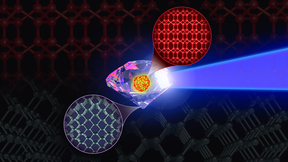New research paper highlights visualization of high-energy electrons in fast-ignition targets
 (Download Image)
In the fast-ignition experiments, high-energy electrons were generated when the laser beam hit the inside of the cone. The top row shows the experimental images and the bottom row depicts simulations performed by LLE scientist Andrey Solodov, a co-author on the Nature Physics paper. By integrating copper into the fuel capsule, the researchers were able to obtain images of K-shell radiation from the copper and analyze the flow of energy.
(Download Image)
In the fast-ignition experiments, high-energy electrons were generated when the laser beam hit the inside of the cone. The top row shows the experimental images and the bottom row depicts simulations performed by LLE scientist Andrey Solodov, a co-author on the Nature Physics paper. By integrating copper into the fuel capsule, the researchers were able to obtain images of K-shell radiation from the copper and analyze the flow of energy.
Fast ignition (FI) is an alternative approach to conventional inertial confinement fusion that involves separating the compression and heating phases of the implosion, using a more stable compression followed by a short burst of localized heating. By separating these two aspects, the fuel can be compressed isochorically (without a central hotspot), reducing the fuel density requirements or increasing the mass of fuel that can be compressed and potentially leading to higher gain. The heating pulse in electron FI is generated by a separate short-pulse petawatt (quadrillion-watt) laser that creates an intense, MeV (million-electron-volt) electron beam that deposits its energy into the compressed core.
Fast ignition requires efficient heating of pre-compressed high-density fuel by an intense relativistic electron beam produced from laser–matter interaction. Understanding the details of electron-beam generation and transport is crucial for FI.
In a paper published in the Jan. 11 issue of Nature Physics, an international team of researchers reported on the first visualization of fast electron spatial energy deposition in a laser-compressed cone-in-shell FI target. Led by Farhat Beg and Charlie Jarrott of UC San Diego and Mingsheng Wei of General Atomics, the team included LLNL scientists Hui Chen, Tilo Döppner, Mike Key, Harry McLean and Prav Patel. The research was facilitated by doping the shell with copper and imaging the K-shell X-ray radiation (the K shell is the electron orbit closest to the nucleus). The experiments were conducted at the OMEGA Laser Facility at the University of Rochester’s Laboratory for Laser Energetics (LLE) as part of the National Laser Users Facility program that provides academic access to the LLE facilities for basic science research.
The experiments show the spatial distribution of the fast electrons and reveal key parameters affecting energy coupling. Successful visualization of relativistic electrons within the FI scheme opens the door to optimizing the target design by providing a more direct way to infer energy coupling.
The technique guided experimental designs that showed a significantly improved laser-to-core coupling energy efficiency of 7 percent. This represents a factor-of-four improvement over previous results for relativistic electron energy coupling to a compressed plastic shell, and is currently the highest coupling efficiency ever reported on the OMEGA Laser Facility. This proven experimental platform could be extended to megajoule-scale laser facilities such as thr National Ignition Facility.
Jarrott, the lead author of the study, recently joined LLNL as a postdoc. The experiments reported in the paper were conducted by Jarrott during his graduate research at UC San Diego. Other institutions involved in the work were Osaka University, the University of Bordeaux and the University of Nevada, Reno.
Contact
 Breanna Bishop
Breanna Bishop
[email protected]
(925) 423-9802
Related Links
Fast ignitionVisualizing fast electron energy transport into laser-compressed high-density fast-ignition targets
Tags
Lasers and Optical S&TLasers
National Ignition Facility and Photon Science
Featured Articles







